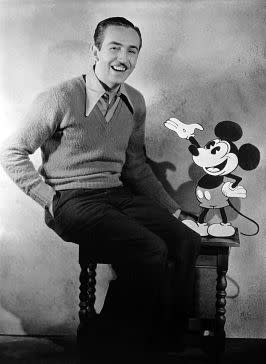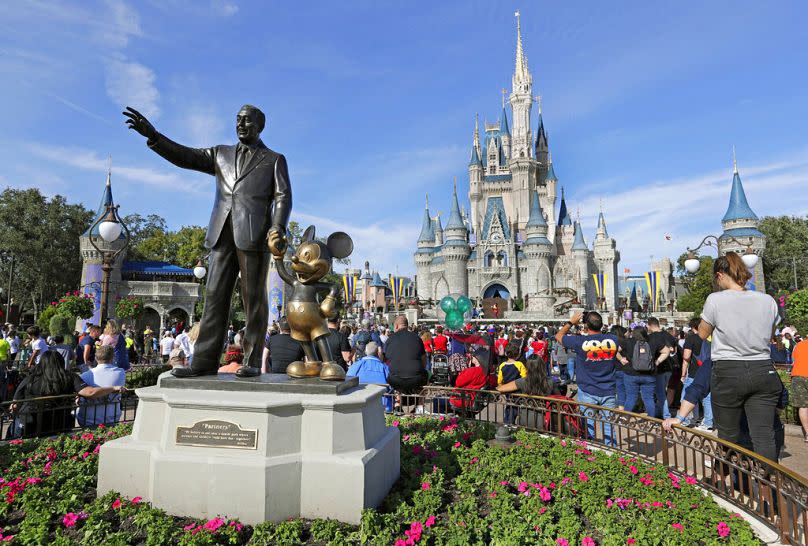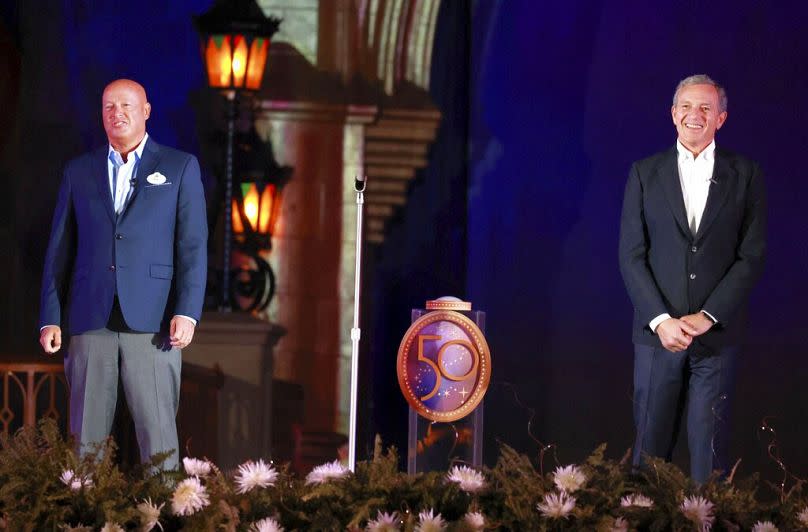Disney turns 100: How a small animation studio came to rule Hollywood

It’s been 100 years since a certain Walter Elias Disney and his brother Roy founded a small animation studio in Hollywood.
The Disney Brothers Studio became the Walt Disney Company, and a century later that small family business is a multinational entertainment monolith worth over €200 billion.
Stretching far beyond animation, Disney now owns Star Wars and Marvel films, as well as sports broadcaster ESPN, National Geographic and entertainment heavyweight 20th Century Fox.
It also runs amusement parks and cruises around the world and operates popular streaming services Disney+, ESPN+ and Hulu.
The world has changed immensely since Walt Disney first picked up his pencil to sketch his now-ubiquitous characters. And the company has weathered many storms along the way – from World War II to the streaming wars of late.
As the dust settles on decades of expansion, where does Disney’s Magic Kingdom stand?
Keeping the magic relevant
From the outset, Disney had to fight to stay relevant in the fast-moving entertainment industry.
For every critically-acclaimed Snow White or Cinderella, there were flops like 1940’s Fantasia or 1985’s Black Cauldron, each one threatening to topple the House of Mouse.

The studio also had to change with the times. In the 90s, it moved into computer animation by partnering with Pixar (owned by Apple’s Steve Jobs) to release instant classics like Toy Story and Finding Nemo.
Disney eventually bought Pixar in 2006, staking its claim as the leader of animation in the 21st century.
That was the first in a series of strategic acquisitions under CEO Bob Iger that catapulted Disney to the top of the media industry, greatly expanding its repertoire beyond animation.
In 2009, the Walt Disney Company bought Marvel Entertainment for around €4 billion. The acquisition of Lucasfilm (home to Star Wars and Indiana Jones) followed in 2012, and then the ultimate deal came in 2017, when Disney took over Hollywood behemoth 20th Century Fox.
Just like that, Disney controlled some of the most popular media franchises in the world. Putting its mammoth production factory to work, it cranked out countless films, series, spinoffs, spinoffs of spinoffs and, of course, merchandise.
These big-budget mega-productions aren’t everybody’s cup of tea, and some of them failed to impress even the most ardent fans (looking at you, The Rise of Skywalker), but they brought in billions of dollars at the box office and kept Disney afloat, even as the COVID-19 pandemic nearly sank the entertainment industry in 2020.
Streaming the Mouse
Disney took advantage of its huge and growing catalogue to launch its own streaming service in 2019, taking on industry leader Netflix along with a host of fellow challengers.
Its flagship streaming service Disney+ gives its 164 million subscribers access to a mind-boggling 500 films, 15,000 episodes and 80 Disney+ originals – including new hits like Wandavision and Encanto, along with all of the classic Disney animated films.
It also owns Hulu and ESPN+, bringing its total subscribers across all three platforms to 235 million, surpassing Netflix’s 223 million last year.
But despite growing its subscriber base faster than expected, Disney’s streaming services are still haemorrhaging money – last year, the direct-to-consumer division lost €1.38 billion ($1.5 billion).
Last November, Disney’s now-sacked CEO Bob Chapek said he expected the company’s streaming arm to turn a profit by 2024. Current CEO Bob Iger reiterated that making Disney’s streaming services profitable was a top priority for the company.
But there are choppy waters ahead – Disney faces an antitrust lawsuit in the United States over its streaming, which alleges that the company is inflating prices for live streaming services across the market.
The Happiest Place on Earth
Walt Disney opened his first theme park in Anaheim, California in 1955. Originally called “The Mickey Mouse Park”, then “Disneylandia”, the name that finally stuck was “Disneyland”.

Today there are 12 Disney parks at six resorts on three continents. The parks are a major source of revenue for the company, bringing in a staggering €26.4 billion ($28.7 billion) in revenues in 2022.
In recent years, however, Disney has been accused of money grabbing by increasing admissions costs for its parks and making visitors pay extra for features that used to be free, like parking and ride photos.
Responding to these criticisms, the company revised its pricing early this year to make certain domestic parks more accessible to people with a smaller budget. This includes expanding the number of days per year where tickets would be sold at their lowest price and offering free photos to all ticketed visitors in 2023.
As analysts warn of an incoming recession, Disney’s theme parks could see the number of visitors drop off. Historically, theme parks have been hit hard by recession as people spend less money on holidays.
Disney’s theme park in Florida has also found itself at the centre of a culture war in the United States.
Last year, right-wing Republican governor Ron DeSantis threatened to scrap the park’s special tax status after Disney reps spoke out against a new repressive law banning primary schools from discussing gender and sexual orientation.
Disney’s game of thrones
As inflation and an economic slowdown weigh on most industries around the world, entertainment companies are entering a new period of crisis.
One of Disney’s most pressing issues is who will takeover the reins when longtime CEO Bob Iger steps down. Iger, who became chief executive in 2005, led Disney through its transformation from LA animation studio to global media powerhouse.
He had tried to hand the keys to the magic kingdom to a hand-picked successor (and fellow Bob) in 2020.

While Bob Chapek is credited with steering Disney through the worst of the COVID-19 pandemic, he was criticised for his handling of several high-profile scandals for the company.
Chapek famously clashed with Black Widow star Scarlett Johansson over the decision to release the 2021 film simultaneously in theatres and on Disney+. He was also called out by LGBTQ+ staff for his hesitancy in speaking out against Florida’s “Don’t Say Gay'' law.
When Disney posted weak results in the last quarter of 2022, sending stock prices plummeting, shareholders called for Chapek’s ouster. Disney – traditionally considered a “Blue Chip” safe-bet stock – saw its shares drop 40 per cent over the year.
Iger came out of retirement to fix the mess, saying he would spend two years as CEO to find a suitable replacement for himself. He's already begun corporate restructuring at the company.
But his successor will have big boots to fill, as Disney enters what’s shaping up to be an unprecedented era for the global entertainment industry.

 Yahoo News
Yahoo News 
